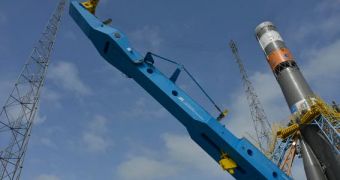Ahead of a planned launch date on Thursday, December 19, officials with the European Space Agency (ESA) have moved their new Gaia space observatory to its South American launch pad. The vehicle was encapsulated in its carrier rocket's payload fairing over the weekend, and is now ready to blast off.
Gaia will be launched into space aboard a Russian-built Soyuz rocket from the Soyuz Launch Complex (ELS), at the Kourou Spaceport, in the French Guiana. Its delivery system, dubbed Soyuz VS06, has been transferred to the ELS on Saturday, December 14, as demonstrated by the image above.
At its point of closest approach to Earth, Gaia's orbit will take the spacecraft within 90,000 kilometers (56,000 miles) of the surface. The farthest the satellite will ever be from Earth is 340,000 kilometers (210,000 miles). Its main eyes are called ASTRO (astrometric instrument), BP/RP (photometric instrument), and RVS (radial velocity spectrometer).
The purpose of the Gaia telescope is to create a 3D map of our galaxy and its immediate surroundings. This will be achieved by mapping the positions of at least a billion stars in the Milky Way and beyond, in a series of all sky-surveys, to span a minimum of 5 years.

 14 DAY TRIAL //
14 DAY TRIAL //